Ch11 - Ch11_Solutions Manual_9ed PDF

| Title | Ch11 - Ch11_Solutions Manual_9ed |
|---|---|
| Author | Antonio Perez |
| Course | Design Of Experiments |
| Institution | Texas Tech University |
| Pages | 84 |
| File Size | 4.1 MB |
| File Type | |
| Total Downloads | 2 |
| Total Views | 265 |
Summary
Solutions from Montgomery, D. C. (2017) Design and Analysis of Experiments, Wiley, NY Chapter 11 Response Surface Methods and Designs Solutions 11. A chemical plant produces oxygen by liquefying air and separating it into its component gases by fractional distillation. The purity of the oxygen is a ...
Description
Solutions from Montgomery, D. C. (2017) Design and Analysis of Experiments, Wiley, NY
Chapter 11 Response Surface Methods and Designs
Solutions 11.1. A chemical plant produces oxygen by liquefying air and separating it into its component gases by fractional distillation. The purity of the oxygen is a function of the main condenser temperature and the pressure ratio between the upper and lower columns. Current operating conditions are temperature (ξ1 ) = -220°C and pressure ratio (ξ2 ) =1.2. Using the following data find the path of steepest ascent. Temperature ( ξ -225 -225 -215 -215 -220 -220 -220 -220
)
Pressure Ratio (ξ 1.1 1.3 1.1 1.3 1.2 1.2 1.2 1.2
)
Purity 82.8 83.5 84.7 85.0 84.1 84.5 83.9 84.3
Design Expert Output Response: Purity ANOVA for Selected Factorial Model Analysis of variance table [Partial sum of squares] Sum of Mean Source Squares DF Square Model 3.14 2 1.57 A 2.89 1 2.89 B 0.25 1 0.25 Curvature 0.080 1 0.080 Residual 0.24 4 0.060 Lack of Fit 0.040 1 0.040 Pure Error 0.20 3 0.067 Cor Total 3.46 7
F Value 26.17 48.17 4.17 1.33
Prob > F 0.0050 0.0023 0.1108 0.3125
not significant
0.60
0.4950
not significant
significant
The Model F-value of 26.17 implies the model is significant. There is only a 0.50% chance that a "Model F-Value" this large could occur due to noise. Std. Dev. Mean C.V. PRESS
0.24 84.10 0.29 1.00
Factor Intercept A-Temperature B-Pressure Ratio Center Point
R-Squared 0.9290 Adj R-Squared 0.8935 Pred R-Squared 0.7123 Adeq Precision 12.702
Coefficient Estimate 84.00 0.85 0.25 0.20
DF 1 1 1 1
Final Equation in Terms of Coded Factors: Purity = +84.00 +0.85 * A +0.25 * B
Standard Error 0.12 0.12 0.12 0.17
95% CI Low 83.66 0.51 -0.090 -0.28
95% CI High 84.34 1.19 0.59 0.68
VIF 1.00 1.00 1.00
Solutions from Montgomery, D. C. (2017) Design and Analysis of Experiments, Wiley, NY
Final Equation in Terms of Actual Factors: Purity = +118.40000 +0.17000 * Temperature +2.50000 * Pressure Ratio
From the computer output use the model yˆ = 84 + 0.85 x1 + 0.25 x2as the equation for steepest ascent. Suppose we use a one degree change in temperature as the basic step size. Thus, the path of steepest ascent passes through the point (x1=0, x2=0) and has a slope 0.25/0.85. In the coded variables, one degree of temperature is equivalent to a step of Δx1 = 1 5 = 0.2 . Thus, Δ x2 = ( 0.25 0.85) 0.2 = 0.059. The path of steepest ascent is: Coded x1 Origin
Δ
Origin + Δ Origin +5 Δ Origin +7 Δ
Variables
0 0.2 0.2 1.0 1.40
Natural
Variables
x2
ξ1
ξ2
0 0.059 0.059 0.295 0.413
-220 1 -219 -215 -213
1.2 0.0059 1.2059 1.2295 1.2413
11.2. An industrial engineer has developed a computer simulation model of a two-item inventory system. The decision variables are the order quantity and the reorder point for each item. The response to be minimized is the total inventory cost. The simulation model is used to produce the data shown in the Table P11.1. Identify the experimental design. Find the path of steepest descent. Table P11.1 Item 1 Order Reorder Quantity (x 1) Point (x 2) 100 25 140 45 140 25 140 25 100 45 100 45 100 25 140 45 120 35 120 35 120 35
Item 2 Order Reorder Quantity (x 3) Point (x 4) 250 40 250 40 300 40 250 80 300 40 250 80 300 80 300 80 275 60 275 60 275 60
Total Cost 625 670 663 654 648 634 692 686 680 674 681
The design is a 24-1 fractional factorial with generator I=ABCD, and three center points. Design Expert Output Response: Total Cost ANOVA for Selected Factorial Model Analysis of variance table [Partial sum of squares] Sum of Mean Source Squares DF Square Model 3880.00 6 646.67 A 684.50 1 684.50 C 1404.50 1 1404.50 D 450.00 1 450.00 AC 392.00 1 392.00
F Value 63.26 66.96 137.40 44.02 38.35
Prob > F 0.0030 0.0038 0.0013 0.0070 0.0085
significant
Solutions from Montgomery, D. C. (2017) Design and Analysis of Experiments, Wiley, NY Curvature Residual Lack of Fit Pure Error Cor Total
815.52 30.67 2.00 28.67 4726.18
1 3 1 2 10
815.52 10.22 2.00 14.33
79.78
0.0030
significant
0.14
0.7446
not significant
The Model F-value of 63.26 implies the model is significant. There is only a 0.30% chance that a "Model F-Value" this large could occur due to noise. Std. Dev. Mean C.V. PRESS
3.20 664.27 0.48 192.50
Factor Intercept A-Item 1 QTY C-Item 2 QTY D-Item 2 Reorder AC AD CD Center Point
R-Squared 0.9922 Adj R-Squared 0.9765 Pred R-Squared 0.9593 Adeq Precision 24.573
Coefficient Estimate 659.00 9.25 13.25 7.50 -7.00 -5.75 9.25 19.33
DF 1 1 1 1 1 1 1 1
Standard Error 1.13 1.13 1.13 1.13 1.13 1.13 1.13 2.16
95% CI Low 655.40 5.65 9.65 3.90 -10.60 -9.35 5.65 12.44
95% CI High 662.60 12.85 16.85 11.10 -3.40 -2.15 12.85 26.22
VIF 1.00 1.00 1.00 1.00 1.00 1.00 1.00
Final Equation in Terms of Coded Factors: Total Cost +659.00 +9.25 +13.25 +7.50 -7.00 -5.75 +9.25
= *A *C *D *A*C *A*D *C*D
Final Equation in Terms of Actual Factors: Total Cost +175.00000 +5.17500 +1.10000 -2.98750 -0.014000 -0.014375 +0.018500
= * Item 1 QTY * Item 2 QTY * Item 2 Reorder * Item 1 QTY * Item 2 QTY * Item 1 QTY * Item 2 Reorder * Item 2 QTY * Item 2 Reorder
ˆ = 659 + 9.25 x1 +13.25 x3 +7.50 x4 . The equation used to compute the path of steepest ascent is y Notice that even though the model contains interaction, it is relatively common practice to ignore the interactions in computing the path of steepest ascent. This means that the path constructed is only an approximation to the path that would have been obtained if the interactions were considered, but it’s usually close enough to give satisfactory results. It is helpful to give a general method for finding the path of steepest ascent. Suppose we have a firstorder model in k variables, say k
yˆ = βˆ0 + ∑ βˆi xi i= 1
The path of steepest ascent passes through the origin, x=0, and through the point on a hypersphere of radius, R where yˆ is a maximum. Thus, the x’s must satisfy the constraint k
Solutions from Montgomery, D. C. (2017) Design and Analysis of Experiments, Wiley, NY
ˆ subject to this constraint, we maximize To find the set of x’s that maximize y k ⎡ k ⎤ L = βˆ0 + ∑ βˆi xi − λ ⎢∑ xi2 − R 2 ⎥ i =1 ⎣ i =1 ⎦
where λ is a LaGrange multiplier. From
∂L ∂L = = 0, we find ∂ xi ∂λ xi =
βˆi 2λ
It is customary to specify a basic step size in one of the variables, say Δxj, and then calculate 2λ as 2λ = βˆ j / Δx j . Then this value of 2 λ can be used to generate the remaining coordinates of a point on the path of steepest ascent. We demonstrate using the data from this problem. Suppose that we use –10 units in ξ1 as the basic step size. Note that a decrease in ξ1 is called for, because we are looking for a path of steepest decent. Now –10 units in ξ1 is equal to –10/20 = –0.5 units change in x1. Thus, 2λ =
βˆ j Δ x1
=
9.25 = − 18.50 −0.5
Consequently,
βˆ3 13.25 = = −0.716 2 λ − 18.50 βˆ 7.50 Δx 4 = 4 = = −0.405 2 λ −18.50 Δx 3 =
are the remaining coordinates of points along the path of steepest decent, in terms of the coded variables. The path of steepest decent is shown below:
Origin
Δ
Origin + Δ Origin +2
x1 0 -0.50 -0.50 -1.00
Coded Variables x2 x3 0 0 0 -0.716 0 -0.716 0 -1.432
Natural Variables x4 0 -0.405 -0.405 -0.810
ξ1
ξ2
120 -10 110 100
35 0 35 35
ξ3 275 -17.91 257.09 239.18
ξ4 60 -8.11 51.89 43.78
Solutions from Montgomery, D. C. (2017) Design and Analysis of Experiments, Wiley, NY 11.3. Verify that the following design is a simplex. Fit the first-order model and find the path of steepest ascent. Position 1 2 3 4
x1 0
x2
− 2
0
0
− 2
2
2 0
x3 -1 1 -1 1
y 18.5 19.8 17.4 22.5
The graphical representation of the design identifies a tetrahedron; therefore, the design is a simplex. Design Expert Output Response: y ANOVA for Selected Factorial Model Analysis of variance table [Partial sum of squares] Sum of Mean Source Squares DF Square Model 14.49 3 4.83 A 3.64 1 3.64 B 0.61 1 0.61 C 10.24 1 10.24 Pure Error 0.000 0 Cor Total 14.49 3
F Value
Prob > F
Std. Dev. R-Squared 1.0000 Mean 19.55 Adj R-Squared C.V. Pred R-Squared N/A PRESS N/A Adeq Precision 0.000 Case(s) with leverage of 1.0000: Pred R-Squared and PRESS statistic not defined
Factor Intercept A-x1 B-x2 C-x3
Coefficient Estimate 19.55 1.35 0.55 1.60
DF 1 1 1 1
Final Equation in Terms of Coded Factors:
Standard Error
95% CI Low
95% CI High
VIF 1.00 1.00 1.00
Solutions from Montgomery, D. C. (2017) Design and Analysis of Experiments, Wiley, NY +1.35 +0.55 +1.60
*A *B *C
Final Equation in Terms of Actual Factors: y +19.55000 +0.95459 +0.38891 +1.60000
The first order model is yˆ
= * x1 * x2 * x3
= 19.55 +1.35 x1 + 0.55 x2 +1.60 x3 .
To find the path of steepest ascent, let the basic step size be in the previous problem, we obtain
Δx3 =
βˆ3 2λ
or 1.0 =
Δx3 =1 . Then using the results obtained 1.60 2λ
which yields 2λ = 1.60. Then the coordinates of points on the path of steepest ascent are defined by
βˆ1 = 1.35 / 1.60 = 0.8 4 2λ βˆ Δx2 = 2 = 0.55 / 1.60 = 0.34 2λ Δ x1 =
Therefore, in the coded variables we have:
Origin
Δ
Origin + Δ Origin +2
Coded x1 0 0.84 0.84 1.68
ˆ = 60 +1.5 x1 11.4. For the first-order model y variables are coded as −1 ≤ xi ≤ 1. Let the basic step size be Δx3 = 1 .
Variables x2 0 0.34 0.34 0.68
x3 0 1.00 1.00 2.00
− 0.8 x2 + 2.0 x3 find the path of steepest ascent. The
2.0 βˆ3 or 1.0 = . Then 2λ = 2.0 2λ 2λ βˆ 1.50 Δx1 = 1 = = 0.75 2λ 2.0 −0.8 βˆ Δx2 = 2 = = −0.40 2λ 2.0
Δ x3 =
Therefore, in the coded variables we have
Solutions from Montgomery, D. C. (2017) Design and Analysis of Experiments, Wiley, NY
Origin
Δ
Origin + Δ Origin +2Δ
Coded x1 0 0.75 0.75 1.50
Variables x2 0 -0.40 -0.40 -0.80
x3 0 1.00 1.00 2.00
11.5. The region of experimentation for three factors are time ( 40 ≤ T1 ≤ 80 min ) , temperature (200 ≤ T2 ≤ 300 °C ), and pressure ( 20 ≤ P ≤ 50psig) . A first-order model in coded variables has been fit to yield data from a 23 design. The model is
yˆ = 30 +5 x1 +2.5 x2 +3.5 x3 Is the point T1 = 85, T2 = 325, P=60 on the path of steepest ascent? The coded variables are found with the following:
P − 35 T − 250 T1 − 60 x3 1 x2 = 2 15 50 20 5 ΔT1 = 5 Δ x1 = = 0.25 20 βˆ 5 Δx1 = 1 or 0.25 = where 2 λ = 20 2λ 2λ βˆ 2.5 Δx 2 = 2 = = 0.125 2λ 20 βˆ 3.5 Δx 3 = 3 = = 0.175 2λ 20
x1 =
Origin
Δ
Origin + Δ Origin +5
Coded x1 0 0.25 0.25 1.25
Variables x2 0 0.125 0.125 0.625
x3 0 0.175 0.175 0.875
Natural T1 60 5 65 85
Variables T2 250 6.25 256.25 281.25
P 35 2.625 37.625 48.125
The point T1=85, T2=325, and P=60 is not on the path of steepest ascent. 11.6. The region of experimentation for two factors are temperature (100 ≤ T ≤ 300 °F ) and catalyst feed rate (10 ≤ C ≤ 3 0lb/h ) . A first order model in the usual fit to a molecular weight response, yielding the following model.
yˆ = 2000 + 125x1 + 40 x 2 (a)
Find the path of steepest ascent.
x1 =
T − 200 100
x2 =
C − 20 10
±1 coded variables has been
Solutions from Montgomery, D. C. (2017) Design and Analysis of Experiments, Wiley, NY
ΔT = 100 Δ x1 =
Δx1 =
Origin
Δ
Origin + Δ Origin +5 Δ
(b)
100 =1 100
βˆ1 125 or 1 = where 2 λ =125 2λ 2λ βˆ 40 Δx2 = 2 = = 0.32 2 λ 125 Coded x1 0 1 1 5
Variables x2 0 0.32 0.32 1.60
Natural T 200 100 300 700
Variables C 20 3.2 23.2 36.0
It is desired to move to a region where molecular weights are above 2500. Based on the information you have from the experimentation in this region, about how many steps along the path of steepest ascent might be required to move to the region of interest?
Δyˆ = Δx1βˆ1 + Δx 2βˆ 2 =( 1)( 125) +( 0.32)( 40) =137.8 2500 − 2000 =3.63 → 4 #Steps = 137.8 11.7. The path of steepest ascent is usually computed assuming that the model is truly first-order.; that is, there is no interaction. However, even if there is interaction, steepest ascent ignoring the interaction still usually produces good results. To illustrate, suppose that we have fit the model
yˆ = 20 + 5x1 − 8x2 + 3x1x2 using coded variables (–1 ≤ x1 ≤ +1) (a)
Draw the path of steepest ascent that you would obtain if the interaction were ignored.
Solutions from Montgomery, D. C. (2017) Design and Analysis of Experiments, Wiley, NY
(b)
Draw the path of steepest ascent that you would obtain with the interaction included in the model. Compare this with the path found in part (a).
11.8. The data shown in Table P11.2 were collected in an experiment to optimize crystal growth as a function of three variables x1, x2, and x3. Large values of y (yield in grams) are desirable. Fit a second order model and analyze the fitted surface. Under what set of conditions is maximum growth achieved? Table P11.2 x1 -1 -1 -1 -1 1 1 1 1 -1.682 1.682 0 0 0 0 0 0 0 0 0 0
x2 -1 -1 1 1 -1 -1 1 1 0 0 -1.682 1.682 0 0 0 0 0 0 0 0
x3 -1 1 -1 1 -1 1 -1 1 0 0 0 0 -1.682 1.682 0 0 0 0 0 0
y 66 70 78 60 80 70 100 75 100 80 68 63 65 82 113 100 118 88 100 85
Solutions from Montgomery, D. C. (2017) Design and Analysis of Experiments, Wiley, NY Design Expert Output Response: Yield ANOVA for Response Surface Quadratic Model Analysis of variance table [Partial sum of squares] Sum of Mean Source Squares DF Square Model 3662.00 9 406.89 A 22.08 1 22.08 B 25.31 1 25.31 C 30.50 1 30.50 A2 204.55 1 204.55 B2 C2 AB AC BC Residual Lack of Fit Pure Error Cor Total
F Value 2.19 0.12 0.14 0.16
Prob > F 0.1194 0.7377 0.7200 0.6941
1.10
0.3191
2226.45
1
2226.45
11.96
0.0061
1328.46 66.12 55.13 171.13 1860.95 1001.61 859.33 5522.95
1 1 1 1 10 5 5 19
1328.46 66.12 55.13 171.13 186.09 200.32 171.87
7.14 0.36 0.30 0.92
0.0234 0.5644 0.5982 0.3602
1.17
0.4353
not significant
not significant
The "Model F-value" of 2.19 implies the model is not significant relative to the noise. There is a 11.94 % chance that a "Model F-value" this large could occur due to noise. Std. Dev. Mean C.V. PRESS
13.64 83.05 16.43 8855.23
Factor Intercept A-x1 B-x2 C-x3 A2 B2 C2 AB AC BC
R-Squared 0.6631 Adj R-Squared 0.3598 Pred R-Squared -0.6034 Adeq Precision 3.882
Coefficient Estimate 100.67 1.27 1.36 -1.49
DF 1 1 1 1
Standard Error 5.56 3.69 3.69 3.69
95% CI Low 88.27 -6.95 -6.86 -9.72
95% CI High 113.06 9.50 9.59 6.73
VIF 1.00 1.00 1.00
-3.77
1
3.59
-11.77
4.24
1.02
-12.43
1
3.59
-20.44
-4.42
1.02
-9.60 2.87 -2.63 -4.63
1 1 1 1
3.59 4.82 4.82 4.82
-17.61 -7.87 -13.37 -15.37
-1.59 13.62 8.12 6.12
1.02 1.00 1.00 1.00
Final Equation in Terms of Coded Factors: Yield +100.67 +1.27 +1.36 -1.49 -3.77
= *A *B *C * A2
* B2 -9.60 * C2 +2.87 * A * B -2.63 * A * C -4.63 * B * C
-12.43
Final Equation in Terms of Actual Factors: Yield = +100.66609 +1.27146 * x1 +1.36130 * x2 -1.49445 * x3 3 76749 * 12
Solutions from Montgomery, D. C. (2017) Design and Analysis of Experiments, Wiley, NY -9.60113 * x32 +2.87500 * x1 * x2 -2.62500 * x1 * x3 -4.62500 * x2 * x3
There are so many non-significant terms in this model that we should consider eliminating some of them. A reasonable reduced model is shown below. Design Expert Output Response: Yield ANOVA for Response Surface Reduced Quadratic Model Analysis of variance table [Partial sum of squares] Sum of Mean Source Squares DF Square Model 3143.00 4 785.75 B 25.31 1 25.31 C 30.50 1 30.50 B2 2115.31 1 2115.31 C2 1239.17 1 1239.17 Residual 2379.95 15 158.66 Lack of Fit 1520.62 10 152.06 Pure Error 859.33 5 171.87 Cor Total 5522.95 19
F Value 4.95 0.16 0.19 13.33 7.81
Prob > F 0.0095 0.6952 0.6673 0.0024 0.0136
0.88
0.5953
significant
not significant
The Model F-value of 4.95 implies the model is significant. There is only a 0.95% chance that a "Model F-Value" this large could occur due to noise. Std. Dev. Mean C.V. PRESS
12.60 83.05 15.17 4735.52
Factor Intercept B-x2 C-x3 B2 C2
R-Squared 0.5691 Adj R-Squared 0.4542 Pred R-Squared 0.1426 Adeq Precision 5.778
Coefficient Estimate 97.58 1.36 -1.49 -12.06 -9.23
DF 1 1 1 1 1
Standard Error 4.36 3.41 3.41 3.30 3.30
95% CI Low 88.29 -5.90 -8.76 -19.09 -16.26
95% CI High 106.88 8.63 5.77 -5.02 -2.19
Final Equation in Terms of Coded Factors: Yield = +97.58 +1.36 * B -1.49 * C -12.06 * B2 -9.23
* C2
Final Equation in Terms of Actual Factors: Yield = +97.58260 +1.36130 * x2 -1.49445 * x3 -12.05546 * x22 -9.22703
* x32
The contour plot identifies a maximum near the center of the design space.
VIF 1.00 1.00 1.01 1.01
Solutions from Montgomery, D. C. (2017) Design and Analysis of Experiments, Wiley, NY
11.9. The data in Table P11.3 were collected by a chemical engineer. The response y is filtration time, x1 is temperature, and x2 is pressure. Fit a second-order model. Table P11.3 x1 -1 -1 1 1 -1.414 1.414 0 0 0 0 0 0 0 Design Expert Output Response: y ANOVA for Response Surface Quadratic Model Analysis of variance table [Partial sum of squares] Sum of Mean Source Squares DF Square Model 273.41 4 68.35 A 31.04 1 31.04 B 16.99 1 16.99 A2 81.39 1 81.39 AB 144.00 1 144.00 Residual 196.59 8 24.57 Lack of Fit 181.79 4 45.45 Pure Error 14.80 4 3.70 Cor Total 470.00 12
x2 -1 1 -1 1 0 0 -1.414 1.414 0 0 0 0 0
y 54 45 32 47 50 53 47 51 41 39 44 42 40
F Value 2.78 1.26 0.69 3.31 5.86
Prob > F 0.1018 0.2937 0.4299 0.1063 0.0418
12.28
0.0162
The "Model F...
Similar Free PDFs

Ch11
- 28 Pages
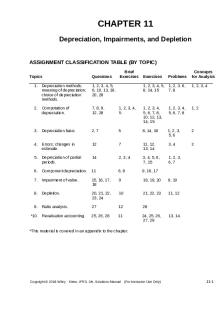
Ch11 - Solution manual ch11
- 83 Pages

Ch11 - kunjaw
- 95 Pages
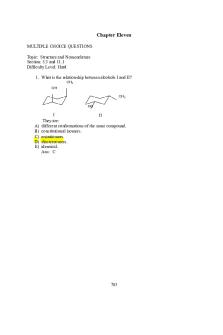
Ch11 - dsdsdssssssssssssssssssssss
- 97 Pages
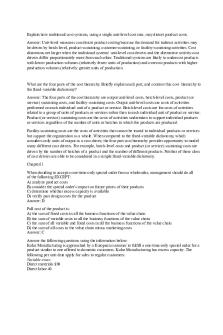
Ch11 - nice
- 16 Pages

Ch11 - accounting
- 49 Pages

Review ch11
- 3 Pages

CH11 Outline
- 15 Pages
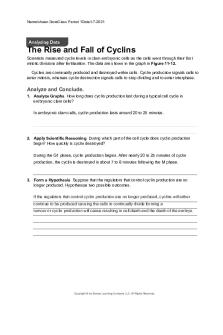
BIO CH11 Analyzing Data
- 1 Pages

Income Tax Banggawan Ch11
- 10 Pages

SM Ch11 - Answer Key
- 20 Pages

Madura IFM10e IM Ch11
- 25 Pages
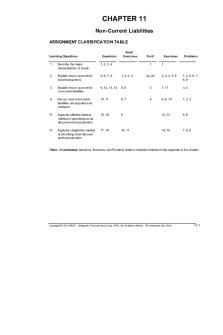
Financial Accounting Ch11 Solution
- 48 Pages
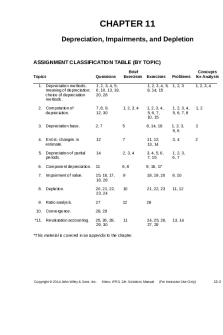
solution manual - Ch11
- 84 Pages

Buckwold 21e Solutions Ch11
- 75 Pages
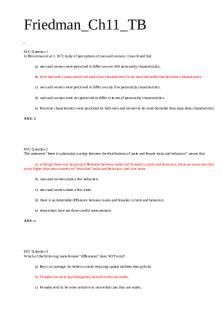
Friedman Ch11 TB - TB
- 15 Pages
Popular Institutions
- Tinajero National High School - Annex
- Politeknik Caltex Riau
- Yokohama City University
- SGT University
- University of Al-Qadisiyah
- Divine Word College of Vigan
- Techniek College Rotterdam
- Universidade de Santiago
- Universiti Teknologi MARA Cawangan Johor Kampus Pasir Gudang
- Poltekkes Kemenkes Yogyakarta
- Baguio City National High School
- Colegio san marcos
- preparatoria uno
- Centro de Bachillerato Tecnológico Industrial y de Servicios No. 107
- Dalian Maritime University
- Quang Trung Secondary School
- Colegio Tecnológico en Informática
- Corporación Regional de Educación Superior
- Grupo CEDVA
- Dar Al Uloom University
- Centro de Estudios Preuniversitarios de la Universidad Nacional de Ingeniería
- 上智大学
- Aakash International School, Nuna Majara
- San Felipe Neri Catholic School
- Kang Chiao International School - New Taipei City
- Misamis Occidental National High School
- Institución Educativa Escuela Normal Juan Ladrilleros
- Kolehiyo ng Pantukan
- Batanes State College
- Instituto Continental
- Sekolah Menengah Kejuruan Kesehatan Kaltara (Tarakan)
- Colegio de La Inmaculada Concepcion - Cebu